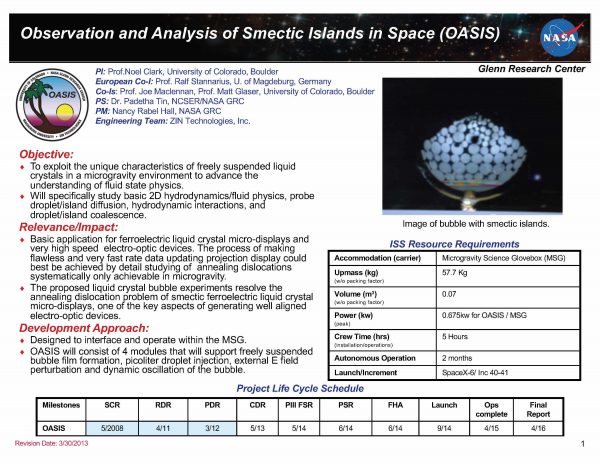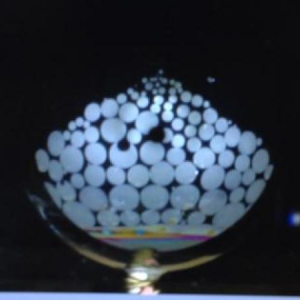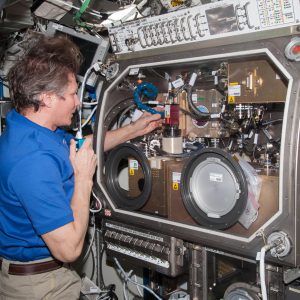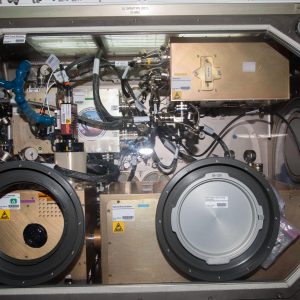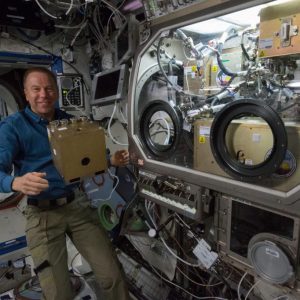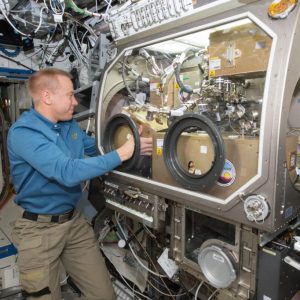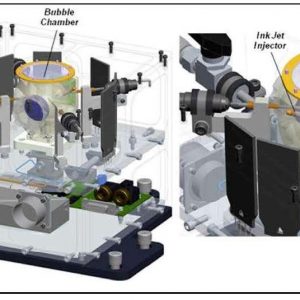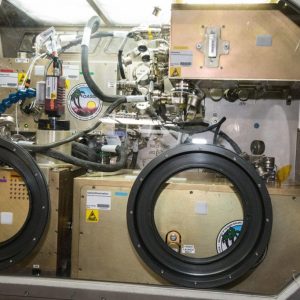OASIS
Observation and Analysis of Smectic Islands in Space (OASIS)
 The Observation and Analysis of Smectic Islands In Space (OASIS) investigation tests theories of hydrodynamic flow, of relaxation of hydrodynamic perturbations, and of hydrodynamic interactions in 2D. Freely suspended bubbles in microgravity, without islands, convection, and sedimentation represent nearly ideal, physically and chemically homogeneous 2D fluid systems for the precision study of 2D hydrodynamics. The effects of introducing islands or droplets is recorded, both as controllable inclusions that modify the flow and as markers of flow.
The Observation and Analysis of Smectic Islands In Space (OASIS) investigation tests theories of hydrodynamic flow, of relaxation of hydrodynamic perturbations, and of hydrodynamic interactions in 2D. Freely suspended bubbles in microgravity, without islands, convection, and sedimentation represent nearly ideal, physically and chemically homogeneous 2D fluid systems for the precision study of 2D hydrodynamics. The effects of introducing islands or droplets is recorded, both as controllable inclusions that modify the flow and as markers of flow.
A second goal is to study the behavior of collective systems of 1D layer step interfaces on 2D bubble surfaces, including the equilibrium spatial organization and interaction of islands, and the nonequilibrium coarsening dynamics of island emulsions. In addition to yielding information about a number of relatively weak physical effects (thickness-dependent surface tension and line tension, disjoining pressure, etc.), researchers anticipate that this will clarify the effects of dimensionality in coarsening dynamics (e.g., on dynamic scaling behavior), and interactions between islands and droplets in regimes where they are very weak, in the smectic A phase and at high temperature in the smectic C phase.
The first thermocapillary tests homogeneous two dimensional fluids. The proposed microgravity experiments present a unique opportunity to explore thermocapillarity, the translational symmetry of the films and the absence of convection mitigating anomalous effects to the maximum extent possible, enabling detailed studies of the thermocapillarity of 2D fluids, also the dependence of surface tension and line tension on film thickness and Burgers vector. Ground-based experiments indicate that equilibrium and nonequilibrium island behavior should be sensitive to this dependence, enabling critical tests of extant theoretical predictions.
Probing the effects of a spontaneously broken symmetry in the 2D film surface (the appearance of 2D polar, XY-like ordering and accompanying electrostatic polarization) on the interaction of islands, exploring the stability of topologically stabilized emulsions of 1D interfaces in 2D.
Space Applications
Future space helmets may use certain types of liquid crystals in small display screens directly applied to the face shield where astronauts can easily view them. Understanding how liquid crystals behave in microgravity helps researchers to design liquid crystal displays (LCDs) that can perform better in space.
Earth Applications
Liquid crystals can flow like a liquid, but contain molecules that are arranged in a specific pattern, just like a crystal. Greater understanding of the physics behind these structures could lead to improved liquid crystal display devices, including devices with improved color contrast and response times. It could also advance research in high-speed electro-optic devices used to control a light beam.
Gallery
Contact Information
Principal Investigator(s)
-
- Noel Clark, Ph.D., University of Colorado. Boulder, Boulder, Colorado, United States
Co-Investigator(s)/Collaborator(s)
-
- Joseph Maclennan, Ph.D., University of Colorado, Boulder, Colorado, United States
- Matt Glaser, Ph.D., University of Colorado, Boulder, Colorado, United States
- Ralf Stannarius, Ph.D., Magdeburg University, D39106 Magdeburg, Germany
- Alexandr Levchenko, Ph.D., Russian Academy of Sciences, Moscow, Russia
- Vladimir Dolganov, Ph.D., Russian Academy of Sciences, Moscow, Russia
- Pavel Dolganov, Ph.D., Russian Academy of Sciences, Moscow, Russia
- Efim Kats, Ph.D., Russian Academy of Sciences, Moscow, Russia

